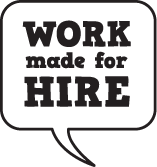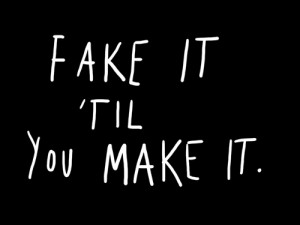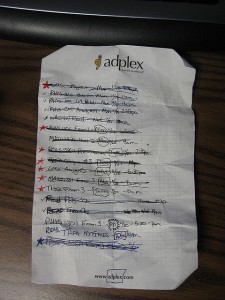The Con Game
I’ve heard the advice,”Fake it ’til you make it!” more times than I care to count. I’ve never given it much thought. I mean, it sounds good and people say it all the time so it must be right, right?
But I started thinking about it this week and I’ve decided I kind of hate it.
Without any context, “Fake it ’til you make it!” is pretty horrible advice. If you fake the wrong thing you run the risk of being branded a liar and ruining your reputation before it can really begin.
Fake what?
When?
How?
My ninjas, here is the secret: fake your confidence, not your skills.
When you’re faking it, keep the puffery to how confident you are about what you’re doing. Don’t tell them you can do something you literally cannot do.
It is far better to be accused of arrogance than it is to be accused of lying.
Look ’em in the eye.
When you shake hands, receive feedback or quote your rate: look them dead in the eye.
Not their shoes, not the table top, not the attractive redhead sitting behind them; no, not even for a second. Eyeballs.
In the United States, not being able to look someone in the eye and make a statement suggests you don’t really believe what you’re saying. It suggests a lack of confidence in your own words. (This belief perseveres despite the fact that it’s not necessarily true; cultural belief often trumps truth.)
So: no sideways glances, no sudden interest in the ceiling, no staring intently at the freckle on their left cheek. Look them in the eye and tell them what you mean.
**Cautionary aside** In other cultures looking someone dead in the face is a great way of saying, “I don’t respect anything you say and I might be a psycho mass murderer.” Whenever possible, know a bit about the culture of the person you’re talking with before you meet them. You have access to the internet; use it.
S-s-stop S-t-t-tuttering About Your P-p-prices
I’m not trying to be a jerk; I know that the first few times you have to quote your rate to someone it is diff-i-cult.
But! Once you’ve settled on a price for your services (there are calculators here and here to help you), get comfortable saying that number out loud and in writing.
For face-to-face meetings, you’ll need to be able to say “$95/hour” without pause or apology. So practice!

By Katie Lane
Make sure your dog and cat know exactly how much your services cost.
Say your rate to your reflection before and after you brush your teeth.
Buy a friend a cup of coffee and role play a couple of client meetings.
Make the words sound common place and boring to the editor that lives in your head.
When you’re quoting a price to a client over email, curb any inclination to over explain or apologize for your price by using templates.
Templates are great! They are ready made emails or documents that only require you to add in a couple of client specific details. Not only will they save you time, they’ll also keep you from re-writing the sentence about rush fees sixteen times in an effort to sound “nicer.”
Most of your work will end up fitting into one of a few categories. Write out an email, beginning to end, explaining how much your services will cost and why for each category.
Then ask a a couple of friends or colleagues to help you edit it. Extra points if they all have different professional backgrounds.
Those extra sets of eyes can help you avoid unnecessary explanations that suggest you aren’t 100% sure this is your price and maybe you’d be totally fine accepting a 50% reduction. Let your trusted friend, not your client, find the insecurities in your writing.
Once the editing is complete you can use these emails every time someone writes asking for a quote. No more creating something from scratch; just pull up the template, fill in the unique details and send it off.
Always have an agenda.
If you are calling a client to discuss the changes they sent over, you should have an agenda: what you need to talk about and the order in which you need to talk about it.
This is true for meetings to get authorizations, phone calls to confirm plans, interviews and, yes, lunch. If you don’t know why you’re there and what you want out of the situation, stay home. Walking into a client situation cold is foolish and unnecessary.
Your agenda can be as benevolent as “see how their boss liked the proposal” or “ask how their mom is,” but it’s still an agenda: you want to know something and you need them to give you an answer.
This is the kind of advice I always hated as a young lawyer and now realize isn’t quite as awful as it sounds when delivered in sound bite-y clipped sentences.
Having an agenda not only makes things easier and more efficient (because you know what you need out of the situation), it also projects your confidence in your work.
Agendas say to your client, “I got this; it’s cool.” If you have an agenda, you obviously know what’s going on so they can follow your lead.
Agendas can also help you calm down. You know what you want to talk about, just follow the agenda and you’ll be fine.
Agendas can act as a sort of confidence life vest. When in doubt follow the agenda.
We all feel off kilter sometimes and need a little boost. Luckily, faking your confidence can weirdly help you feel more confident. So fake it; you’ll make it just fine.
Categories: Self Awareness Tools






This is spot on. I was advised (by someone who should know better!) that I should just walk into a place and bullshoop my way into a writing job. This someone also said she knew a ton of people who had done this.
Well pardon me, but isn’t it bad to lie about your credentials/experience? What did she think would happen when they find out I can’t do the X and Y the job requires, but only Z? This was told to me by the same person who said a couple of years before that she had to fire a writer who had misrepresented herself!